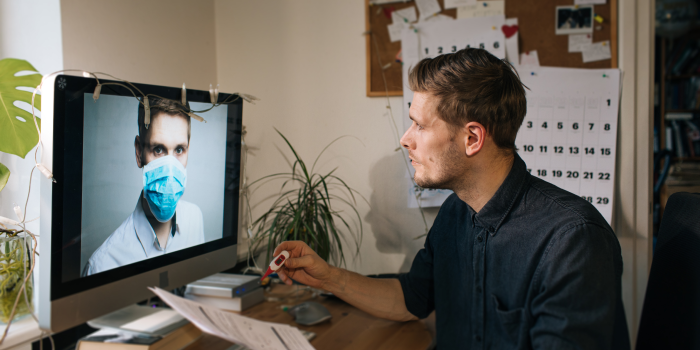How Curogram Helped Increase COVID-19 Vaccinations
The COVID-19 (coronavirus) pandemic has led to a significant expansion of telemedicine to deliver healthcare services because of movement...

Healthcare professionals play a critical role in debunking COVID-19 myths that either scare people or make them doubt the public health emergency and the measures in place to counter it. It is important to point these false claims out and shed light on each of them to help inform and educate patients about their health decisions.
Since the COVID-19 or coronavirus/SARS-CoV-2 outbreak began in 2019 and was declared a pandemic by the World Health Organization (WHO) in March of 2020, myths continue to surround it. Many people around the world still subscribe to a myriad of false claims on the origin, spread, and cures for the disease, horrifying assumptions about the vaccines, and concocted stories that disregard the existence of the virus and the gravity of this public health emergency. It’s no wonder, given the COVID-19 myths, that there is a shared reluctance to health protocols and vaccination.
It is the duty of healthcare professionals (HCPs) to continuously educate patients and debunk these myths by shedding light on each misconception.
It is in the best interest of patients that their doctors inform and educate them to help sift through an influx of information on the internet, which certainly includes fake and malicious information.
Here is a compilation of COVID-19 myths that patients encounter, hear, and read. Regardless of the source, you must be ready to identify them, and if they're deceptive or wrong, be there for your patients to debunk and provide the correct information.
This information is a rumor. You can tell your patients that no evidence has so far come out to back up the claim that COVID-19 originated from a lab leak. On the contrary, a scientific study published in March 2020 demonstrates SARS-CoV-2, the virus that causes COVID-19, is a natural product of evolution rather than an experiment that broke out from a laboratory in China.
This is very trivial but causes some people to worry. Help your patients understand that scientific research points to animals like pangolins and bats as the original host of the virus that later jumped to humans. Scientists, however, discount that eating bat soup is the cause of the COVID-19 outbreak.
It's critical for your patients to understand how COVID-19 spreads and who is at risk in order to protect themselves. Here are some frequently heard myths about the spread of the coronavirus.
Explain to your patients that COVID-19 makes anyone vulnerable to severe symptoms that result in hospitalization or death, regardless of age. Adults 65 years and older and those with comorbidities are at higher risk of suffering from severe illness.
According to the Centers for Disease Control (CDC), while reports are rare, reinfection of COVID-19 is possible and expected. Even if your patients overcome the illness, it is still possible to get infected again. So, it would help if you make sure your patients are aware of this so they keep following health protocols such as wearing a mask in public, staying away from crowds, and washing their hands.
It does. Tell your patients. The odds may vary, but small get-togethers are still a potential source of acquiring COVID-19 infection. The likelihood of getting infected increases without social distancing and not wearing masks.
Help your patients understand that people with COVID-19 are sometimes asymptomatic but still spread the virus to others.
When your patients test negative for COVID-19, it means they do not have the disease during the examination. But, it is helpful if you advise your patients to protect themselves from the virus because they may get sick later on and test positive.
Explain to your patients that wearing a mask is just one of the public health measures they should observe to reduce the spread of COVID-19. Along with wearing a mask, the CDC still recommends social distancing (6 feet away from others).
This is another trivial claim but, yet again, affects people's behaviors and actions. The conspiracy theory that COVID-19 spreads over 5G is clearly a myth. Debunk this with patients and share that experts contradict this theory.
You can reveal to your patients that scientists have concluded that the virus cannot survive on letters or packages for extended periods. The CDC also explains that it is unlikely for the coronavirus to spread from domestic or international mail, even though the virus can survive for a short period on some surfaces.
If your patients love Chinese food, let them rejoice, as they won't catch COVID-19 when they eat it.
According to the CDC, no evidence suggests that SARS-CoV-2 transmits via the water in swimming pools, hot tubs, or water parks. However, if you use public pools, spas, or waterparks, you must still maintain social distance and follow other safety protocols to reduce the risk of transmission.
Getting the currently authorized COVID-19 vaccines may prevent patients from developing severe symptoms, requiring hospitalization, and, potentially, death. A recent CDC science brief says that “the risk for SARS-CoV-2 infection in fully vaccinated people cannot be completely eliminated as long as there is continued community transmission of the virus.”
Less than 67% of Americans are currently fully vaccinated for COVID-19. Myths, disinformation, and conspiracy theories are significantly contributing to this public health problem. Some of the most common myths include:
You can debunk this myth by explaining to your patients that world leaders and drug companies needed to act quickly to provide the public with the required vaccines during a global pandemic. They spent lots of time and money preparing and making the COVID-19 vaccines to be ready as soon as possible. It does not mean, though, that the vaccines are unsafe. In the United States, all vaccines go through rigorous studies and tests that ensure they're safe and work, and the Food and Drug Administration (FDA) regulates vaccine rollouts in the country.
You can ask your patients to rest their worries and tell them that none of the COVID-19 vaccines in the United States or other countries contain the live virus that causes COVID-19. In other words, a COVID-19 vaccine can't make you sick.
According to the CDC, scientific studies negate this claim, and there is no evidence that a COVID-19 vaccine causes infertility.
It's normal for viruses to mutate or develop new strains. For COVID-19, scientists have found multiple strains worldwide, including in the United Kingdom, South Africa, and Brazil. They spread more quickly, but there's no proof that they make the vaccinated sicker or cause more deaths. FDA emergency use authorized or approved COVID-19 vaccines help protect against Delta and other known variants.
This is not entirely true. Some people have a severe allergic reaction (called anaphylaxis) to the COVID-19 vaccine in rare cases. Advise your patients not to take the vaccine if they're allergic to any ingredient in a COVID-19 vaccine. However, they can get the vaccine if they have an animal, food, pollen, or another type of common allergy.
As vaccine hesitancy is high, many people turn to these 10 home remedies, regimens, or alternatives to cure COVID-19, which are primarily myths.
You can tell your patients that supplements, such as vitamins D and C and the mineral zinc, help boost the immune system and protect against viruses. However, when it comes to COVID-19, there's no evidence that they offer a cure or are a treatment if a person already has the disease.
While water is vital for overall health, science doesn't support the idea that drinking warm water protects anyone from COVID-19. The only thing it might do is soothe the throat and ease a cough if your patient is already sick. Instead of drinking warm water, tell your patient to wash their hands with it.
The basis for this myth could be factual: that the coronavirus dies at a very high temperature (149°F for three minutes). However, the idea of taking a hot bath at this temperature level is not advisable as these temperatures can burn the skin. Washing with soap and warm water already gets rid of viruses on hands that could transfer to the eyes, nose, and mouth.
Doctors advise using saline in the nose to relieve natural allergies or the common cold. However, there is no proof that rinsing the nose with it prevents someone from getting COVID-19.
The SARS-CoV-2 virus can tolerate hand dryers. It is best to make your patients aware that hand dryers don't kill the virus. Frequent hand washing for 20 seconds is still the best protection from the coronavirus. Tell them to use an alcohol-based hand sanitizer if hand washing is not possible.
Antibiotics only kill bacteria. They do not kill viruses. It would benefit your patients if they understood the difference.
Studies support the antibiotic properties of garlic as it can inhibit the growth of certain bacteria. Aside from the fact that a virus and not a bacteria cause COVID-19, there is no evidence to support that garlic can also protect people from COVID-19.
Some viruses, such as cold and flu viruses, spread quickly in colder months. That does not mean their transmission stops in warmer weather. Advise your patients not to be complacent when the weather is warmer, as COVID-19 cases are high in warmer areas.
SARS-CoV-2 is a distinct variation of coronavirus and a different type of virus than influenza. That's why the existing flu and pneumonia vaccines do not offer protection against it. Make sure your patients understand this to encourage them to take the COVID-19 vaccine as well as their annual flu shot.
Experts agree that alcohol can disinfect the skin. However, it does not have the same effect when inside the body. According to the WHO, the consumption of alcohol poses health risks: "... consuming high-strength ethyl alcohol (ethanol), particularly the one adulterated with methanol, can result in severe health consequences, including death." Your patients benefit from this advice, so make sure they know this. .
Patients are entitled to believe anything they want if it’s right for them. HCPs, however, have a responsibility to their patients. While respecting their right to beliefs, you must make an effort to reach out and educate your patients about the facts of COVID-19 — it's real and deadly for some, but vaccines help protect and prevent them from getting severely ill or ending up in hospital.
Prevention is still the best way to combat COVID-19. It is best to encourage your patients to follow health protocols strictly. And you can guide them to follow credible sources of information from government agencies or private institutions.
Engage and educate your patients by sending automated reminder text messages about COVID-19, informing them that you are available for consultation. Sponsor special virtual private or group meetings via telemedicine that focus on COVID-19 concerns so you can initiate patient education.
Doctors are the best defense against misconceptions that influence patients’ actions and behaviors towards their health. You are their COVID-19 myth buster.

The COVID-19 (coronavirus) pandemic has led to a significant expansion of telemedicine to deliver healthcare services because of movement...

Patients prefer receiving and sending text messages with their healthcare providers because it is more efficient and provides greater accessibility....

The COVID-19 pandemic changed how many industries manage their day-to-day operations, healthcare included. With lockdowns that prevented people from...